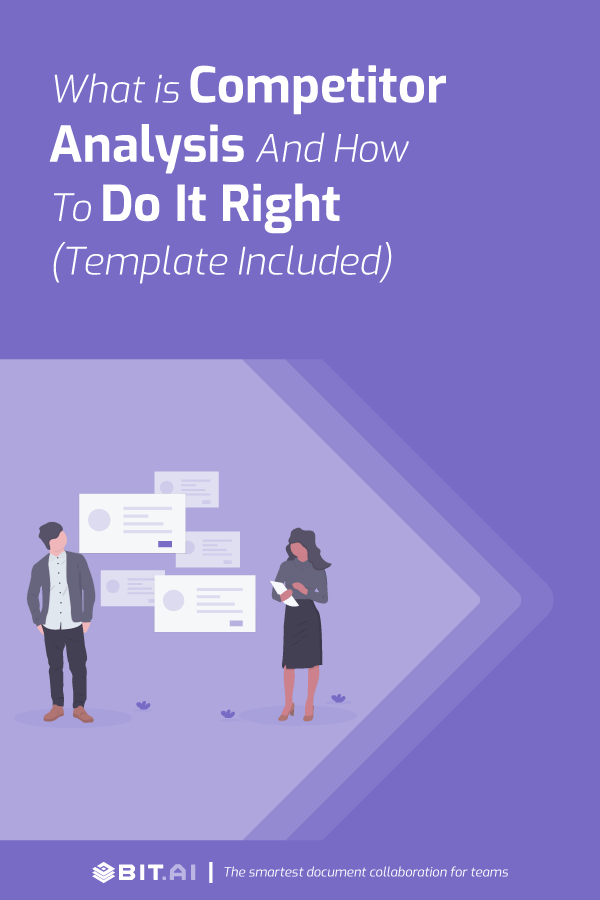Competitor Analysis is crucial for determining how your business stacks up against the competition. It’s a smart way to look for areas for improvement and opportunities. If you haven’t been conducting a periodic competitor analysis, don’t worry, we’ve got your back. Today we will cover everything there is to know about competitor analysis that will put you in the driver’s seat.
There is one group of people who love competition. Take a wild guess…
Consumers!
Consumers are the ones who actually benefit from competition. As companies try to outsmart each other by:
- Bringing new products to market quicker
- Improving the quality of their products and services
- Reducing prices
- Catering to the needs of each and every customer
However, if you are a business…competition can be well, deadly.
Unless you are selling jewelry made out of rocks from Mars, you likely have competition. You’re not alone. Every company in every niche does.
It doesn’t matter if you are a Coca-Cola or a small mom and pop store. You are either stealing other customers or having your business taken away from you.
Understanding the competition and keeping an eye on what they are up to is critical to your business success and growth. Most marketing plans incorporate competitor analysis or competitive intelligence.
Having knowledge about your competition’s market approach, strategies, and marketing messages, can help you remain one step ahead. It’s a battle to gain your customer’s mindshare.
One of the overwhelming reasons why more than half of the marketers feel they are not very good at competitor analysis is their lack of strategy.
If you are someone who needs help to stay ahead of the competition by leveraging competitive intelligence, this blog post is for you. Let’s start with the basics.
What Is Competitor Analysis? (Definition)
Investopedia defines competitive intelligence as:
“The process of collecting and analyzing information about competitors’ strengths and weaknesses in a legal and ethical manner to enhance business decision-making.”

No, it’s not about hiring a private detective to spy on your rivals. We wouldn’t recommend you to go that far!
At Bit.ai, we define competitive intelligence as:
“Researching information about your competitors that already exists in the public domain and utilizing it to your advantage.”
With technological advancement becoming a regular affair, it has never been easier to find out about a rival company and see what they are up to.
You can literally just Google the type of product or service you are offering and get a list of companies offering similar products or services in your niche.
Why Is Competitor Analysis Important?
Researching and analyzing your organization’s competitors helps you discover:
- Current and potential threats in the market
- Identify opportunities in the marketplace to give you an edge over others.
- Discover its USP (unique selling proposition)
- Your’s and your competitor’s weaknesses
According to the Kauffman Index, over 550,000 new businesses are started each month in the US alone.
More and more people are starting up businesses of their own, creating a lot of competition for consumer mindshare. On top of that…in a world of globalization, your competition is not limited to your zip code, but anywhere in the world.
There can be two girls selling items from their basement on Amazon which is similar to yours. Competitive intelligence is important, especially for new startups and businesses that lack millions of dollars for marketing.
Knowing how your competitors are killing it and replicating it can save you thousands of dollars in experimentation. Competitor’s intelligence helps you to find answers to questions that can make or break your success.
- How is my business different than the competition?
- Does my website load faster or slower than competitors?
- Why does my competitor have higher ratings than me on Amazon?
- Why do their Facebook fans keep growing?
- How are they able to keep their prices so low?
- What do my customers think of my company compared to my competitors?
- What makes my product/service offering unique?
Your competition is not limited to your zip code.
The aim of any business is not only to satisfy the needs of customers but to do it better than their competitors.
By getting answers to the above questions, businesses can see if they are on the right track or they need some catching up to do.
How To Do Competitor Analysis?
A quick Google search can provide you a list of companies and businesses selling something similar to you. However, more advanced tools are helping the company gain crucial insights regarding its competitors.
Tools like Buzzsumo, Google Trends, Hubspot and Alexa rankings are exceptional in providing insights for competitor websites like traffic sources, demographics, ad impressions, website load speeds, referral sources, keyword research, etc.
For businesses other than those existing on the internet, Davidson, in his book “Even More Offensive Marketing,” gave an exceptional model to collect competitor analysis from three different sources:
Recorded Data: Recorded data includes information that is formally published by the organization or by external sources. For example a company’s annual reports, newspaper or magazine articles, press releases, etc.
Observable Data: This type of data can be collected by simply observing your competitors from an arm’s length. This could include product pricing, service offerings, ad campaigns, etc.
Opportunistic Data: Opportunistic data is collected strategically. This includes talking or meeting with their customers, their suppliers or partners, and their former and current employees. It also includes attending trade shows, seminars and scoping out the competition, etc.
The important part is not only to collect this vital information but to put it together in a meaningful way. Your company ultimately needs to reap its benefits and plan accordingly.
Here are some of the steps you need to follow to conduct a thorough competitor analysis:
1. Set Your Goals
First and foremost, you have to decide what you want to accomplish out of your competitor’s analysis.
- Are you looking to exploit your competitor’s weaknesses?
- Are you looking for new market opportunities that your competitors have ignored?
- Do you want to refine your marketing message?
- Do you need a design overhaul?
 Knowing your analysis goals upfront will provide you with better insight on how to research, develop an action plan, and execute.
Knowing your analysis goals upfront will provide you with better insight on how to research, develop an action plan, and execute.
2. Identify Competition
The next step is to identify competitors offering similar products or services. These include current as well as potential competitors.
To find who your competitors are, you can do the following:
- Ask your customers who else they are considering for the same product.
- Do a Google search or use tools like Alexa, Similar Web or Buzzsumo.
- Identify competitors by attending trade shows, conferences, and seminars.
- If you own a retail shop or e-commerce business, search on Amazon to find companies selling similar products.
- Keep up-to-date with industry and market news related to your product to spot any up and coming competitors.
3. Collect Data
Once you know who your competitors are, you can kickstart your analysis by collecting data about them. As mentioned earlier, data can be divided into three sections: 1) recorded 2) observational and 3) opportunistic data.
Scout through these resources and collect as much data as possible. For your competitor’s internet presence, you will want to evaluate and answer the following questions::
Their website:
- How fast does it load? What is the color scheme?
- What’s their design and brand style?
- What type of ad placements do they have?
- What are their landing page optimization techniques?
Their content marketing strategy:
- What content marketing strategies do they use?
- How often do they blog?
- Do they publish short-form or long-form content?
- Are they trying new marketing avenues like podcasting and video marketing?
Their social media presence:
- How many fans or followers do they have?
- Are they making use of influencer marketing?
- What kind of ads are they are posting?
- Which age groups or demographics are they targeting?
- How often do they post on social media?
Read more: 15 Business Intelligence Tools & Software Every Business Needs!
4. Analyze and Compare Data
Once you have collected all the data you need, it’s time to analyze it. Merely collecting data is of no use until you put it to work. Comparing your own strategies, tactics, and metrics against your competitors can give you macro-level insight.

You may gain insight into trends in the market and opportunities you are missing out on. For example, if you are getting only 2% of your traffic from social media and your competitors are getting upwards of 10%, you know it’s time to revamp your social media strategy.
5. Identify Areas for Improvement and Opportunity
After completing the competitor analysis, you now have a clear understanding of what your competitors are up to. It’s time to put this information to good use by finding out areas of improvement.
Is it your social media strategy that’s stopping you from becoming dominant in your space? Is your customer service on par with your competitors? Does your product match in quality with your rivals? All of these questions can be answered through competitor analysis.
Competitor Analysis Template:
Here is a beautiful template to help you create an amazing Competitor’s analysis!
Major Takeaways for Competitor Analysis
Competitor analysis answers three key questions about your competitive landscape:
- What’s happening around you? (what your competitors are up to.)
- Why is it happening? (What are the strategies implemented by them.)
- What can you do about it? (What areas can you improve)
By staying on top of your rivals, your company can quickly react to the competition and develop strategies accordingly. Competitor analysis should not be taken lightly and should be performed from time to time to actually reap the benefits.
There’s little to no benefit in doing a competitor analysis when your rivals have already taken a big step and acquired the majority of the market share.
The competitor analysis allows your company to:
- Stay Ahead of your competitors
- Learn from the mistakes of other companies
- Get insight into industry trends
- Compare yourself with industry leaders, aka Benchmarking.
- Stand out from the crowd
- Replicate and modify successful competitor strategies and tactics
We all have heard the saying “knowledge is power.” Having the knowledge about your competitors and the market can serve you with a great deal of power and advantage over your rivals.
What are your thoughts on competitor analysis? How often do you keep track of your competitors? Let us know in the comments section below!
How To Create Reports That “Wow” Your Clients?
Competitive Strategy: Definition, Types, Importance & More!
Marketing Research: Definition, Process & Tools!
Reputation Management: What is it & How to Do it?
KPI Report: What it is & How to Create a Perfect One?
Brand Authenticity: Definition, Importance & Tips To Build It!
Objectives and Key Results (OKR): What, Why, and How?
What is SWOT Analysis: The Complete Guide

Related posts
About Bit.ai
Bit.ai is the essential next-gen workplace and document collaboration platform. that helps teams share knowledge by connecting any type of digital content. With this intuitive, cloud-based solution, anyone can work visually and collaborate in real-time while creating internal notes, team projects, knowledge bases, client-facing content, and more.
The smartest online Google Docs and Word alternative, Bit.ai is used in over 100 countries by professionals everywhere, from IT teams creating internal documentation and knowledge bases, to sales and marketing teams sharing client materials and client portals.
👉👉Click Here to Check out Bit.ai.


